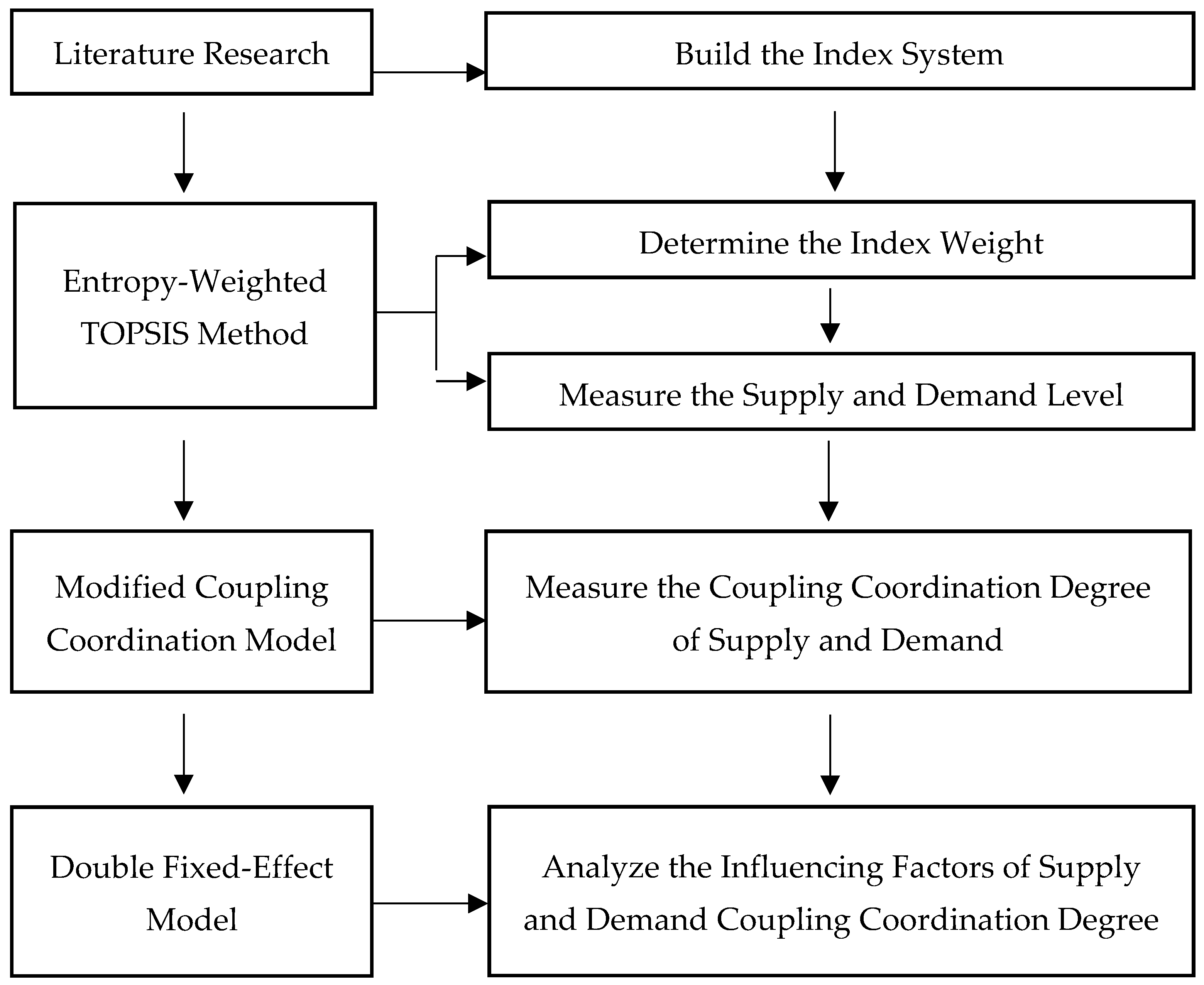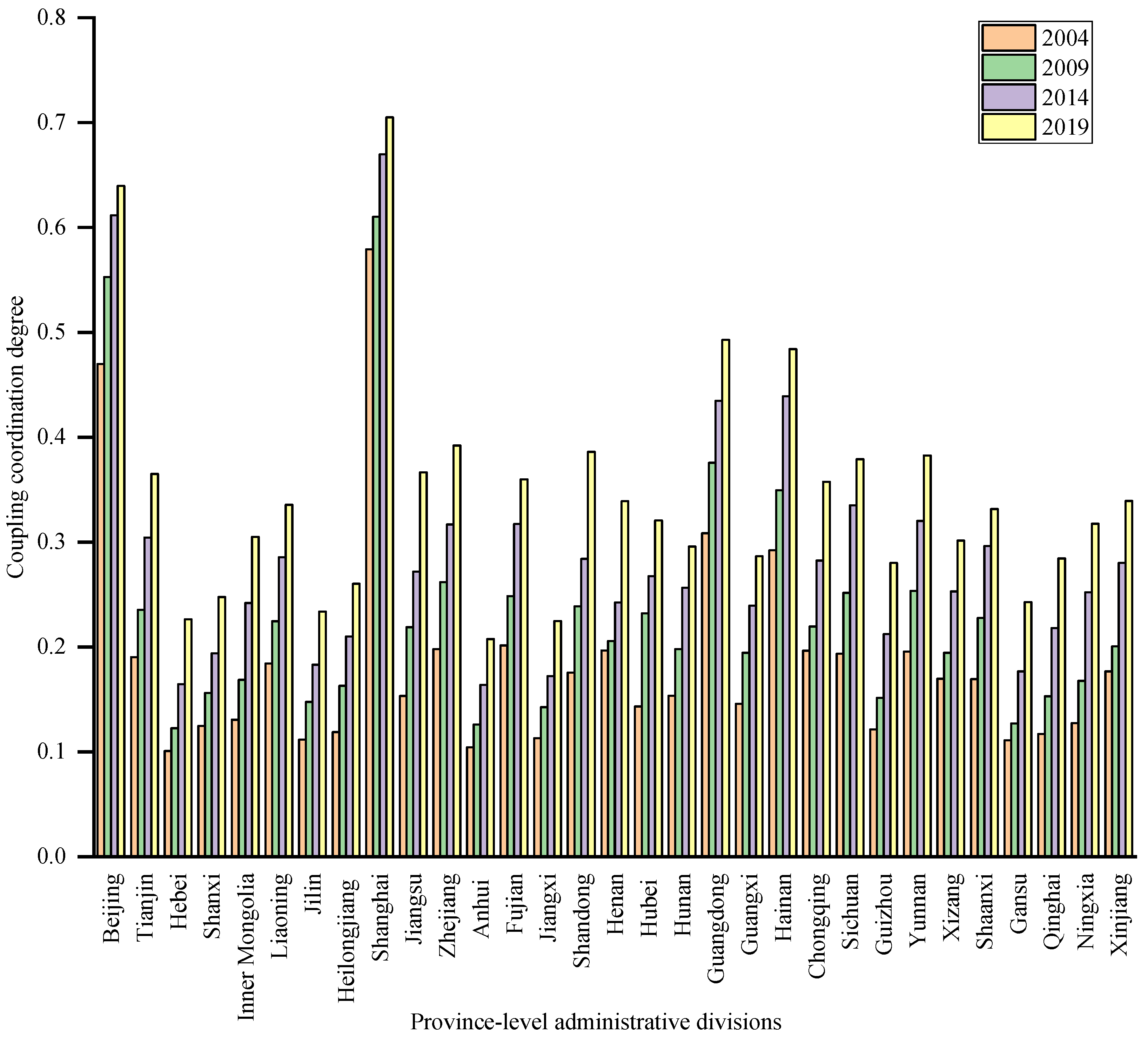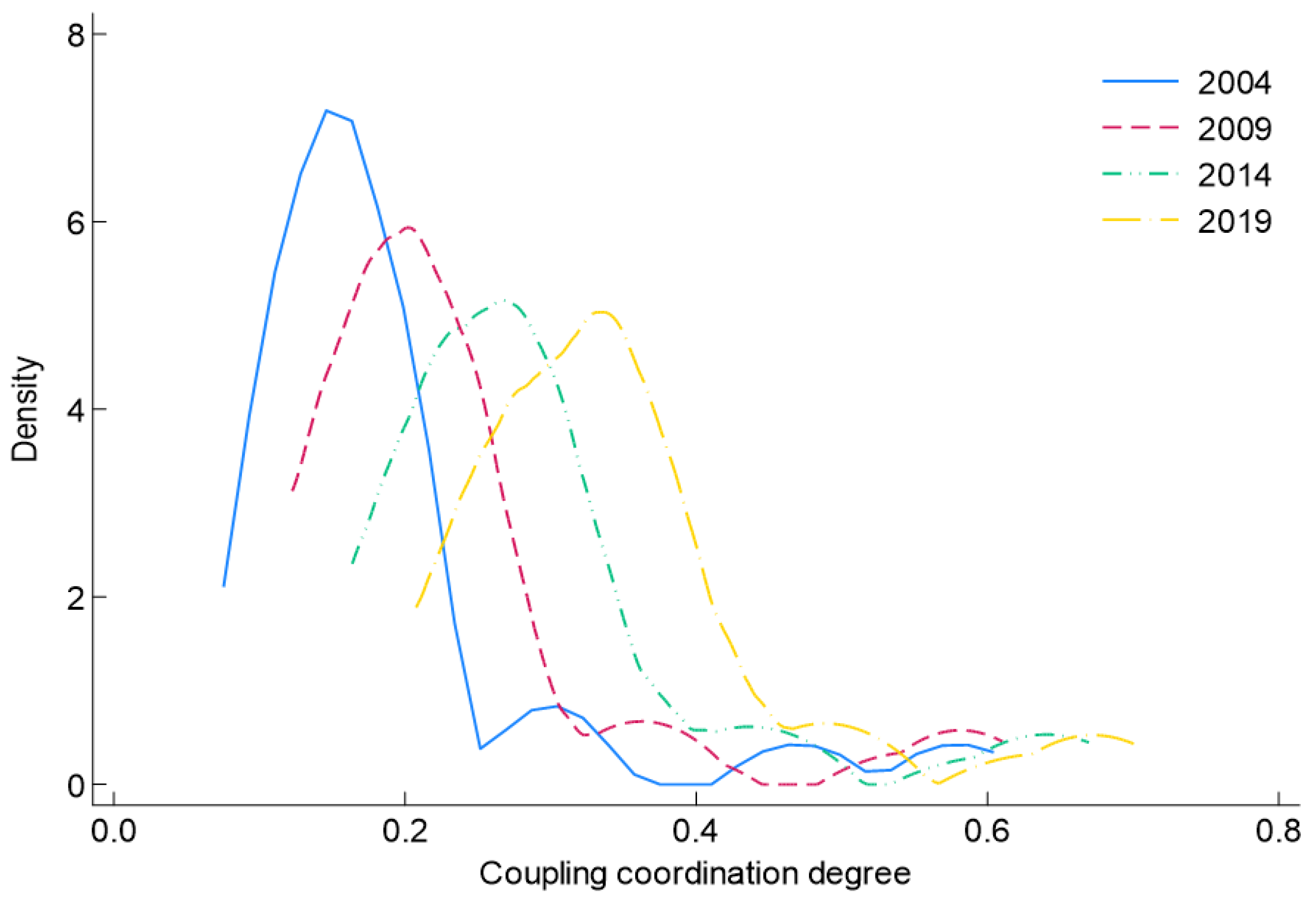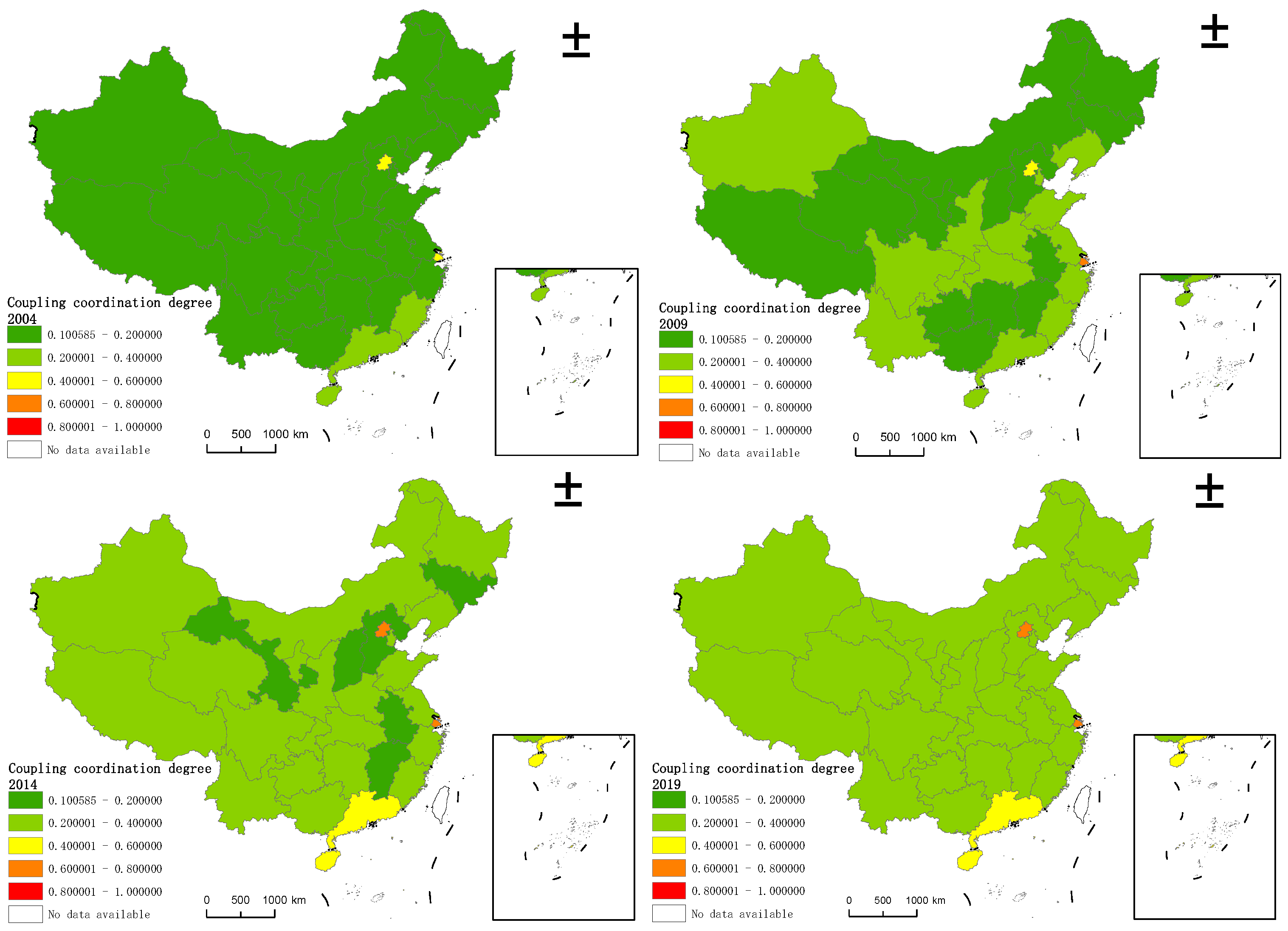Spatio-Temporal Evolution and Influencing Factors of Supply–Demand Coupling and Coordination in Civil Aviation Passenger Transport
Abstract
1. Introduction
2. Literature Review
3. Research Methods
3.1. Study Framework
3.2. Evaluation Index System of Supply and Demand of Civil Aviation Passenger Transport
3.3. Data Source
3.4. Methods
3.4.1. Entropy-Weighted TOPSIS Method
3.4.2. Modified Coupling Coordination Degree Model
3.4.3. Kernel Density Estimation
3.4.4. Global Spatial Autocorrelation Analysis
3.4.5. Measurement Model
4. Results
4.1. Coupling Coordination Analysis
4.1.1. Time Characteristics Analysis of Supply–Demand Coupling Coordination Degree of Civil Aviation Passenger Transport
4.1.2. Analysis of Spatial Characteristics of Supply–Demand Coupling Coordination Degree of Civil Aviation Passenger Transport
4.2. Global Spatial Correlation Test
4.3. Influencing Factors of Coupling Coordination Degree
5. Conclusions
- (1)
- China’s civil aviation passenger supply, demand and supply–demand coupling coordination degree show a steady upward trend. From 2004 to 2019, the average annual growth rates of China’s civil aviation passenger supply, demand and their coupling and coordination were 4.97%, 8.66% and 4.19%. The average annual growth rate of demand exceeds that of supply and coupling coordination. The overall coupling and coordination relationship between supply and demand is on the rise, indicating that the relationship between supply and demand is gradually optimizing.
- (2)
- In terms of time series, in 2000, the top five province-level administrative divisions in the supply–demand coupling coordination degree were Shanghai, Beijing, Guangdong, Hainan and Fujian, and the last five were Jiangxi, Jilin, Gansu, Anhui and Hebei. In 2019, the top five province-level administrative divisions in the supply–demand coupling coordination degree were Shanghai, Beijing, Guangdong, Hainan and Zhejiang, and the last five province-level administrative divisions were Gansu, Jilin, Hebei, Jiangxi and Anhui. Shanghai, ranked first, is 3.4 times that of Anhui, ranked last. There are differences in the degree of coupling coordination among province-level administrative divisions in China. The province-level administrative divisions with high coordination degree are mostly those with superior natural conditions, developed economies and perfect transportation infrastructure. The province-level administrative divisions with low coordination degree are mostly those with poor natural conditions, low levels of economic development and poor transportation infrastructure. This is closely related to natural conditions, socio-economic foundation and regional development strategies. Balanced development should be promoted through policy guidance and regional development strategies.
- (3)
- In terms of spatial variation, the coupling coordination degree of each province-level administrative division exhibits a consistent trend, showing a yearly increase. In 2004, 83.97% of the provincial coupling coordination degree was in extreme imbalance. In 2009, 48.39% of the province-level administrative divisions were in low coordination. In 2014, 67.74% of the province-level administrative divisions were in low coordination. In 2019, no province-level administrative division was in extreme imbalance, and all province-level administrative divisions were in low-level coordination and above. From 2004 to 2019, the province-level administrative divisions with high coordination, moderate coordination and low coordination showed a trend of spatial expansion, and the province-level administrative divisions with extreme imbalance showed a trend of spatial convergence. The supply–demand coupling coordination degree in all province-level administrative divisions has been raised to the upper level. Extreme coordination has not yet appeared. On the whole, the coupling and coordination level of China’s civil aviation passenger transport supply and demand needs to be improved.
- (4)
- The development of economic level, the improvement of urbanization rate and the enhancement of opening degree can actively promote the coupling and coordinated development of civil aviation passenger transport supply–demand. These factors are the key driving factors to strengthen the synergy between supply and demand of civil aviation passenger transport. These factors work together in the civil aviation passenger transport market. By improving residents’ income, increasing consumption capacity and expanding the international market, the growth of air transport demand has been promoted, and the quality and capacity of air transport services have been improved. The benign interaction between supply and demand is realized, and the coupling and coordinated development of civil aviation passenger transport supply and demand is promoted.
Author Contributions
Funding
Institutional Review Board Statement
Informed Consent Statement
Data Availability Statement
Conflicts of Interest
References
- Shao, G. Research on the Evaluation and Promotion of the Competitiveness of Hub Airport. Master’s Thesis, Wuhan University of Technology, Wuhan, China, 2011. [Google Scholar]
- Pashkevich, A.; Nommik, A.; Antov, D. Competitiveness Analysis of Regional Airports Based on Location Planning Models: The Case Study of Finland. In Proceedings of the 21st International Scientific Conference on Transport Means (Transport Means), Juodkrante, Lithuania, 20–22 September 2017; Kaunas University Technology Press: Kaunas, Lithuania, 2017; pp. 754–761. [Google Scholar]
- Zhang, Y.; Jin, X.; Li, M.; Liu, R.T.; Jing, Y. Evaluating civil aviation airport competitiveness in the Yangtze River Economic Belt of China: A lens of spatial-temporal evolution. Front. Environ. Sci. 2022, 10, 14. [Google Scholar] [CrossRef]
- Zhang, X.; Du, Q.; Xu, Z.L.; Tao, H.Q. Construction of evaluation index system of regional multi-airport coordinated development in the Yangtze River Delta region. In Proceedings of the 7th International Conference on Computing and Convergence Technology (ICCCT), Seoul, Republic of Korea, 3–5 December 2012; IEEE: Piscataway, NJ, USA, 2012; pp. 338–341. [Google Scholar]
- Zhu, C.; Gu, P.; Xu, Z. Domestic airport competitiveness evaluation based on entropy weight TOPSIS method. J. Beijing Jiaotong Univ. 2019, 43, 124–130. [Google Scholar]
- Cui, Q.; Kuang, H.-B.; Wu, C.-Y.; Li, Y. Dynamic formation mechanism of airport competitiveness: The case of China. Transp. Res. A Policy Pract. 2013, 47, 10–18. [Google Scholar] [CrossRef]
- Lei, X.; Haibin, Y.; Xu, L.; Qing, Z. System Dynamics Modeling and Simulation Analysis on Airport Competitiveness, AADNIC-ABMECR 2021. In Proceedings of the 3rd Africa-Asia Dialogue Network (AADN) International Conference on Advances in Business Management and Electronic Commerce Research, Ganzhou, China, 26–28 November 2021; pp. 49–58. [Google Scholar]
- Huynh, T.M.; Kim, G.; Ha, H.-K. Comparative analysis of efficiency for major Southeast Asia airports: A two-stage approach. J. Air Transp. Manag. 2020, 89, 9. [Google Scholar] [CrossRef]
- Patrícia Belfiore, F. Critical Success Factors to Evaluate the Efficiency of Brazilian Airports; FAPESP: São Paulo, Brazil, 2017. [Google Scholar]
- Fu, Z.; Shao, Y.; Xiao, J.; Wang, S. Operational Efficiency of Major Airports in China Based on Dual-Oriented DEA Model. J. Transp. Syst. Eng. Inf. Technol. 2013, 13, 193–199. [Google Scholar]
- Cifuentes-Faura, J.; Faura-Martínez, U. Measuring Spanish airport performance: A bootstrap data envelopment analysis of efficiency. Util. Policy 2023, 80, 9. [Google Scholar] [CrossRef]
- Miao, Y.; Wang, C.; Wu, Y.; Yuan, Y.; Xu, H. The Spatio-Temporal Evolution Characteristics of Chinas Civil Airports Structure and Its Optimization. Econ. Geogr. 2017, 37, 37–45. [Google Scholar]
- Jia, P.; Hu, Y.; Kuang, H. Evolution analysis and driving factors of spatial distribution pattern of airport traffic in China. Syst. Eng. Theory Pract. 2019, 39, 1198–1211. [Google Scholar]
- Ma, S.; Zhao, Z.; Zhao, Z.; Bai, B. Evolution and influencing factors of air passenger transport in China from 2000 to 2019. Sci. Geogr. Sin. 2023, 43, 1011–1021. [Google Scholar]
- Yu, S.; Miao, Y.; Wang, C.; Wang, J.; Hu, R.; Chen, P.A. The Location Entropy of China’s Civil Aviation Passenger Transport: Spatiotemporal Characteristics and Influencing Factors. Econ. Geogr. 2023, 43, 35–43. [Google Scholar]
- Dziedzic, M.; Njoya, E.T.; Warnock-Smith, D.; Hubbard, N. Determinants of air traffic volumes and structure at small European airports. Res. Transp. Econ. 2020, 79, 13. [Google Scholar] [CrossRef]
- Marazzo, M.; Scherre, R.; Fernandes, E. Air transport demand and economic growth in Brazil: A time series analysis. Transp. Res. E Logist. Transp. Rev. 2010, 46, 261–269. [Google Scholar] [CrossRef]
- Profillidis, V.; Botzoris, G. Air passenger transport and economic activity. J. Air Transp. Manag. 2015, 49, 23–27. [Google Scholar] [CrossRef]
- You, K.; Xiong, J. Airline Passenger Numbers Impact Analysis based on the Income Elasticity. In Proceedings of the 2nd International Conference on Computer Engineering, Information Science and Internet Technology (CII), Sanya, China, 11–12 November 2017; Destech Publications, Inc: Lancaster, PA, USA, 2017; pp. 560–565. [Google Scholar]
- Xu, W.H. Influencing Factors and Trend Prediction of Passenger Throughput of Shanghai Civil Aviation Airport. Master’s Thesis, Shanghai Academy of Social Sciences, Shanghai, China, 2019. [Google Scholar]
- Wu, X.; Man, S. Air transportation in China: Temporal and spatial evolution and development forecasts. J. Geogr. Sci. 2018, 28, 1485–1499. [Google Scholar] [CrossRef]
- Hoyos, D.T.; Olariaga, O.D. Behavior of Air Passenger Demand in a Liberalized Market. Transp. Telecommun. J. 2020, 21, 1–14. [Google Scholar] [CrossRef]
- İnan, T.T.; Gökmen, R. The determination of the factors affecting air transportation passenger numbers. Int. J. Aviat. Aeronaut. Aerosp. 2021, 8, 4. [Google Scholar]
- Prentice, C.; Kadan, M. The role of airport service quality in airport and destination choice. J. Retail. Consum. Serv. 2019, 47, 40–48. [Google Scholar] [CrossRef]
- Liao, W.; Cao, X.; Li, T.; Gao, X. The Influence of Airport Service Quality on Air Travel Choices: A Case Study of the Guangdong-Hong Kong-Macao Greater Bay Area. Trop. Geogr. 2024, 44, 195–211. [Google Scholar]
- Wang, J.E.; Hu, H. Competition and cooperation of high-speed rail and air transport in China: A perspective from spatial service market view. Acta Geogr. Sin. 2013, 68, 175–185. [Google Scholar]
- Gu, W.; Guo, B.; Zhang, Z.; Lu, H. Civil Aviation Passenger Traffic Forecasting: Application and Comparative Study of the Seasonal Autoregressive Integrated Moving Average Model and Backpropagation Neural Network. Sustainability 2024, 16, 17. [Google Scholar] [CrossRef]
- Suryani, E.; Chou, S.-Y.; Chen, C.-H. Air passenger demand forecasting and passenger terminal capacity expansion: A system dynamics framework. Expert Syst. Appl. 2010, 37, 2324–2339. [Google Scholar] [CrossRef]
- Zhao, Z.-X.; Wang, H.-X.; Qiu, Y.-Q.; Lu, X.-L. The Application of a Time Series Forecasting Model in Air Passenger Volume Prediction Research. In Proceedings of the 2nd International Conference on Modeling, Simulation and Optimization Technologies and Applications (MSOTA), Xiamen, China, 25–26 November 2018; Destech Publications, Inc.: Lancaster, PA, USA, 2018; pp. 43–47. [Google Scholar]
- Jichao, L.; Xiaolei, C.; Xiaoyong, L. Aviation Business Volume Forecast of Xianyang International Airport Based on Multiple Prediction Models. IOP Conf. Ser. Mater. Sci. Eng. 2019, 688, 022028. [Google Scholar]
- Cheng, L. Combined forecasting of civil aviation passenger volume based on ARIMA-REGRESSION. Int. J. Syst. Assur. Eng. Manag. 2019, 10, 945–952. [Google Scholar]
- Hu, Y.-C. Air passenger flow forecasting using nonadditive forecast combination with grey prediction. J. Air Transp. Manag. 2023, 112, 12. [Google Scholar] [CrossRef]
- Hen, Y.; Li, Y. Comparison of Two Grey Models’ Applicability to the Prediction of Passenger Flow in Sanya Airport, Data Science. In Proceedings of the 9th International Conference of Pioneering Computer Scientists, Engineers and Educators, ICPCSEE 2023, Harbin, China, 22–24 September 2023; pp. 225–236. [Google Scholar]
- Anupam, A.; Lawal, I.A. Forecasting air passenger travel: A case study of Norwegian aviation industry. J. Forecast. 2024, 43, 661–672. [Google Scholar] [CrossRef]
- Javanmard, M.E.; Tang, Y.; Martínez-Hernández, J.A. Forecasting air transportation demand and its impacts on energy consumption and emission. Appl. Energy 2024, 364, 20. [Google Scholar] [CrossRef]
- Liang, X.; Hong, C.; Chen, J.; Wang, Y.; Yang, M. A hybrid forecasting architecture for air passenger demand considering search engine data and spatial effect. J. Air Transp. Manag. 2024, 118, 21. [Google Scholar] [CrossRef]
- Zhao, S.X. Research on the Economic Adaptability Theory and Evaluation of Airport Construction Scale. Ph.D. Thesis, Southwest Jiaotong University, Chengdu, China, 2017. [Google Scholar]
- Nasution, D.; Mawengkang, H.; Zarlis, F.M. An Analysis Air Traffic Prediction During a Pandemic. In Proceedings of the 2022 4th International Conference on Cybernetics and Intelligent System (ICORIS), Medan, Indonesia, 8–9 October 2022; pp. 1–6. [Google Scholar]
- Mehmood, B.; Aleem, M.; Shahzad, N. Air-Transport and Macroeconomic Performance in Asian Countries: An Analysis. Pak. J. Appl. Econ. 2015, 25, 179–192. [Google Scholar]
- Jiao’e, W.; Han, W.; Jingjuan, J. Measurement of the relationship between China’s air transport industry and tourism development level. Sci. Geogr. Sin. 2016, 36, 1125–1133. [Google Scholar]
- Ji, K.W.; Qi, J.B. The coupling coordination degree of China’s aviation and tourism industry and its spatial effect analysis. Res. Financ. Educ. 2020, 33, 10–21. [Google Scholar]
- Zhang, W.; Yin, R.; Zhan, Y.; Zhang, X. Interaction between civil aviation transportation and tourism development in the western China. Sci. Geogr. Sin. 2023, 43, 1774–1782. [Google Scholar]
- National Bureau of Statistics of China. Statistical Yearbook of China; China Statistics Press: Beijing, China, 2005–2020. [Google Scholar]
- Civil Aviation Administration of China. Civil Aviation Airport Production Statistics Bulletin; Civil Aviation Administration of China: Beijing, China, 2004–2019. [Google Scholar]
- Civil Aviation Administration of China. Civil Aviation from a Statistical Perspective; Civil Aviation Administration of China: Beijing, China, 2005–2020. [Google Scholar]
- Zhang, G.H. China Civil Airport; Volume I and Volume II; China Civil Aviation Press: Beijing, China, 2008. [Google Scholar]
- China Academy of Civil Aviation Science and Technology. China Civil Aviation Statistical Data Compilation (1949–2011); China Civil Aviation Publishing House: Beijing, China, 2014. [Google Scholar]
- China Civil Airport Encyclopedia. National Airport Information List; Civil Aviation Administration of China: Beijing, China, 2021. [Google Scholar]
- Xiong, X.X.; Zhang, X.L.; Guo, W.C.; Zhang, Q.L. Research on spatio-temporal evolution of modern marine cities based on entropy weight TOPSIS method-obstacle degree model-modified coupling coordination degree model. Mar. Sci. Bull. 2024, 43, 784–796. [Google Scholar]
- Wang, S.J.; Kong, W.; Ren, L.; Zhi, D.; Dai, B. Misconceptions and corrections of the domestic coupled coordination degree model. Nat. Resour. J. 2021, 36, 793–810. [Google Scholar]






| Target Layer | Criterion Layer | Sub-Criterion Layer | Indicator Layer | Property |
|---|---|---|---|---|
| Coupling coordination of supply and demand of civil aviation passenger transport | Supply level | Facilities system | Number of airports (pcs) | + |
| Airport density (pcs/10000 km2) | + | |||
| Number of airports per million people (pcs/million people) | + | |||
| Number of runways (strip) | + | |||
| Airport terminal area (hectare) | + | |||
| Service system | Number of aviation employees (person/year) | + | ||
| Proportion of civil aviation employees (%) | + | |||
| Demand intensity | Demand status | Passenger throughput (person-time) | + | |
| Aircraft take-off and landing sorties (time) | + | |||
| Single-runway aircraft take-off and landing sorties (time/strip) | + | |||
| Passenger throughput per square kilometer (person/km2) | + | |||
| Demand potential | Annual growth rate of passenger throughput (%) | + | ||
| Annual growth rate of aircraft take-off and landing sorties (%) | + | |||
| Ratio of passenger throughput to resident population | + |
| Coupling Coordination Type | Extreme Incoordination | Low Coordination | Moderate Coordination | High Coordination | Extreme Coordination |
|---|---|---|---|---|---|
| D-value interval | 0 < D ≤ 0.2 | 0.2 < D ≤ 0.4 | 0.4 < D ≤ 0.6 | 0.6 < D ≤ 0.8 | 0.8 < D ≤ 1 |
| Year | I | Z | p |
|---|---|---|---|
| 2004 | 0.055 | 0.857 | 0.196 |
| 2005 | 0.109 | 1.362 | 0.087 |
| 2006 | 0.123 | 1.474 | 0.070 |
| 2007 | 0.127 | 1.496 | 0.067 |
| 2008 | 0.161 | 1.817 | 0.035 |
| 2009 | 0.087 | 1.119 | 0.132 |
| 2010 | 0.084 | 1.085 | 0.139 |
| 2011 | 0.065 | 0.932 | 0.176 |
| 2012 | 0.048 | 0.761 | 0.223 |
| 2013 | 0.065 | 0.907 | 0.182 |
| 2014 | 0.085 | 1.079 | 0.140 |
| 2015 | 0.075 | 0.983 | 0.163 |
| 2016 | 0.080 | 1.030 | 0.152 |
| 2017 | 0.110 | 1.297 | 0.097 |
| 2018 | 0.116 | 1.352 | 0.088 |
| 2019 | 0.110 | 1.284 | 0.100 |
| Influencing Factors | Explanatory Variable | Country |
|---|---|---|
| Economic development | Per capita GDP | 0.5399 *** (3.95) |
| Population agglomeration | Population density | 0.1378 (0.84) |
| Urbanization level | Urbanization rate | 0.0804 ** (2.12) |
| Government regulation | Per capita fiscal expenditure | 0.1605 (0.60) |
| Tourism development level | Ratio of number of domestic tourists to resident population | −0.0002 (−0.88) |
| Opening to the outside world | Ratio of total import and export to GDP | 0.0189 ** (2.11) |
| Industrial structure | Proportion of the added value of the tertiary industry to GDP | 0.0301 (0.87) |
| Traffic location conditions | Railway density | 0.0637 (0.25) |
| - | Year FE | YES |
| - | Province FE | YES |
| - | R2 | 0.9878 |
Disclaimer/Publisher’s Note: The statements, opinions and data contained in all publications are solely those of the individual author(s) and contributor(s) and not of MDPI and/or the editor(s). MDPI and/or the editor(s) disclaim responsibility for any injury to people or property resulting from any ideas, methods, instructions or products referred to in the content. |
© 2025 by the authors. Licensee MDPI, Basel, Switzerland. This article is an open access article distributed under the terms and conditions of the Creative Commons Attribution (CC BY) license (https://creativecommons.org/licenses/by/4.0/).
Share and Cite
Yang, Y.; Hu, M.; Yin, J.; Wu, W. Spatio-Temporal Evolution and Influencing Factors of Supply–Demand Coupling and Coordination in Civil Aviation Passenger Transport. Appl. Sci. 2025, 15, 1362. https://doi.org/10.3390/app15031362
Yang Y, Hu M, Yin J, Wu W. Spatio-Temporal Evolution and Influencing Factors of Supply–Demand Coupling and Coordination in Civil Aviation Passenger Transport. Applied Sciences. 2025; 15(3):1362. https://doi.org/10.3390/app15031362
Chicago/Turabian StyleYang, Yanling, Minghua Hu, Jianan Yin, and Wei Wu. 2025. "Spatio-Temporal Evolution and Influencing Factors of Supply–Demand Coupling and Coordination in Civil Aviation Passenger Transport" Applied Sciences 15, no. 3: 1362. https://doi.org/10.3390/app15031362
APA StyleYang, Y., Hu, M., Yin, J., & Wu, W. (2025). Spatio-Temporal Evolution and Influencing Factors of Supply–Demand Coupling and Coordination in Civil Aviation Passenger Transport. Applied Sciences, 15(3), 1362. https://doi.org/10.3390/app15031362






